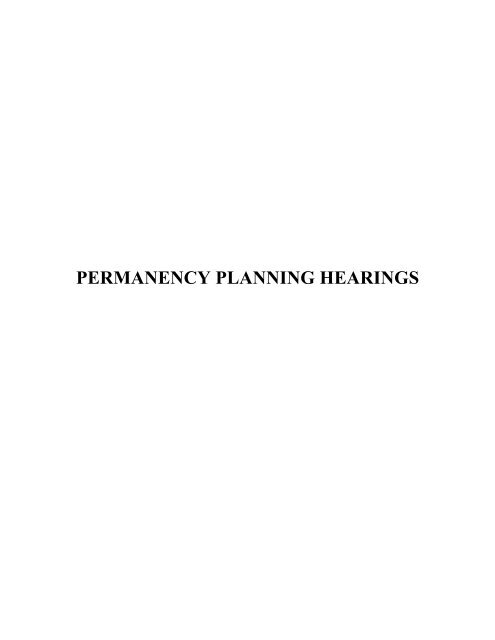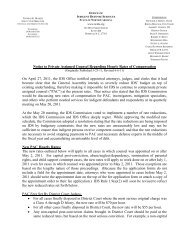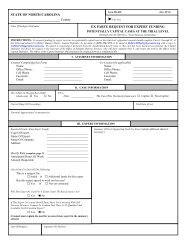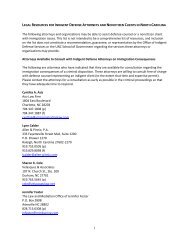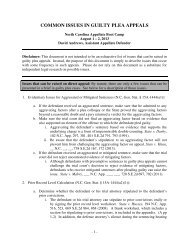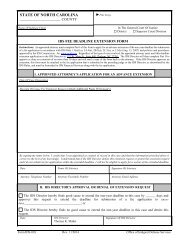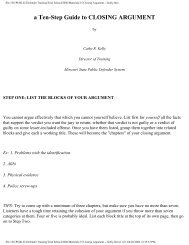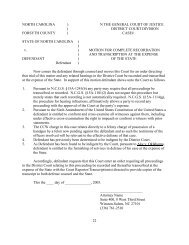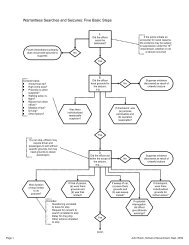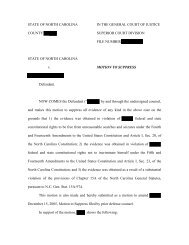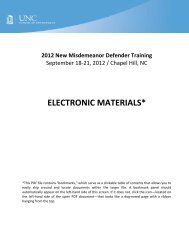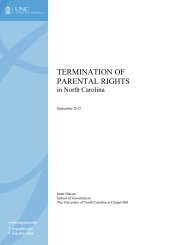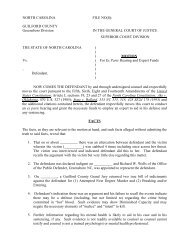PERMANENCY PLANNING HEARINGS
PERMANENCY PLANNING HEARINGS
PERMANENCY PLANNING HEARINGS
You also want an ePaper? Increase the reach of your titles
YUMPU automatically turns print PDFs into web optimized ePapers that Google loves.
<strong>PERMANENCY</strong> <strong>PLANNING</strong> <strong>HEARINGS</strong>
<strong>PERMANENCY</strong> <strong>PLANNING</strong> <strong>HEARINGS</strong>Permanency planning hearings differ from regular review hearings in that they do notconsider routine oversight of the case. Permanency planning hearings actually represent a deadlinefor all parties and are used to determine the final direction of the case. N.C.G.S. § 7B-907 requiresthat “where custody is removed from a parent, guardian, custodian, or caretaker, the judge shallconduct a review hearing designated as a permanency planning hearing within 12 months after thedate of the initial order removing custody.” The statute allows for a review hearing and apermanency planning hearing to be combined if appropriate. The stated purpose of the permanencyplanning hearing is to develop a plan wherein the child achieves a safe, stable and permanent homewithin a reasonable period. The statute further requires that permanency planning hearings be heldat least every six months thereafter, but allows the court to set them earlier as needed. As in reviewhearings, the Department of Social Services requests the clerk to calendar the hearing and providesnotice to all parties. The same parties entitled to notice in a review hearing, including a child over12, are entitled to notice of the permanency planning hearing. The court is required to considerinformation from the agency and any other parties that may have input that will assist the court informulating a permanent plan. The court, as in review hearings, may consider hearsay evidence atthe hearing if the court finds the information to be relevant, reliable and necessary.One way to consider the difference between a review hearing and a permanency planninghearing is to look at the review hearing as a way to fine tune the case plan while a permanencyplanning hearing is to decide on permanent placement of the child. If the court does not treat thepermanency planning hearing with greater deference than the regular reviews, the child may remainin foster care longer than necessary. The permanency planning hearing is the opportunity for thecourt to decide if the child is likely to return home or, if the parents have not and likely will not makesufficient progress in a reasonable time, the plan should change to one of guardianship or adoption.The court should carefully consider all options when it comes to permanency and reasonably shouldconsider adoption first over other long term arrangements. In some cases, as with review hearings,the facts are so egregious that the court may move to a permanency planning hearing immediately.Under these circumstances, the matter will continue to be reviewed but the court will enter apermanent plan to reflect the best interest of the child much sooner than normal.I. WHO SHOULD BE PRESENTThe same parties that are important and necessary for review hearings should be partof the permanency planning hearing for the same reasons.II.KEY DECISIONS FOR THE COURTDecisions made at a permanency planning hearing need to be more specific and finalthan a regular review hearing. The court should examine each child’s options as related topermanent placement and deal with each option in turn as follows:Page 1 of 8
WHEN CHILD WILL BE RETURNING HOME BY A CERTAIN DATE.If the parent is successful in completing the requirements of the case plan andthe court decides the child should return home, a specific date should be set. Thisprovides all parties with a specific goal to aid in preparing for the move back to thehome of the parent.CHILD WILL BE LEGALLY FREE FOR ADOPTION.If it becomes clear that the child will not be able to return home the courtshould consider a formal termination of parental rights in order to free the child foradoption. At the permanency planning hearing the court can determine if atermination proceeding should be filed or has previously been filed. If the courtmakes this determination, the director of the department of social services shall filea petition to terminate parental rights within 60 days of the permanency planninghearing unless the court makes written findings why the petition can not be filedwithin 60 days. If the court does consider adoption, members of the child’s extendedfamily should be considered. If there are no such family members, the court shouldconsider foster parents where the child is placed.CUSTODY TO OTHERS ON A PERMANENT BASIS (GUARDIANSHIP)If it is determined that a child cannot be safely returned home, another optionis placement with a relative or other responsible adult. The court should state clearlyin the record why the child cannot return home and provide clear findings as to whythe child will not be adopted. A transitional plan should be ordered if the placementis not immediately available or if the child needs further treatment or services beforebeing placed. When the court uses this option, it accomplishes two things withoutterminating the rights of the parents: (a) it ends the supervisory role of the agency andthe juvenile court; and (b) it grants permanent care and control to someone other thana parent. One positive aspect of this option is that the parent may be ordered tocontinue paying child support and may be allowed visitation and communication withthe child. This also leaves the door open for a parent to seek relief from the court inthe future by way of a motion to modify custody if the behaviors and shortcomingsthat brought them into the system are alleviated.FOSTER CARE ON A PERMANENT OR LONG-TERM BASIS.This should be an absolute last resort when it comes to permanency. If thecourt considers the option of extended foster care with a short-term goal ofreunification, the following determinations should be addressed: (a) the parent hasPage 2 of 8
made significant progress on the case plan; (b) a close and positive relationshipbetween the child and parent has been maintained; ( c ) it may be likely the child willreturn home in the short-term, but no specific date can be set. As stated this shouldbe a last resort for the court and the court should do a thorough inquiry into thereasons for it in order to prevent repeated decisions that delay permanency.III.SUBMISSION OF REPORTSThe intention to set a permanency planning hearing in the future should be announcedby the court at a regular review hearing in order to put all parties on notice. The agencyshould petition the court to hold the hearing when appropriate and provide adequate noticeto all parties of the date of the hearing. The report prepared by the agency in anticipation ofthe permanency planning hearing should encompass the following: (a) the relief being soughtand; (b) point out the specific issues the court will need to address and rule on. The reportsshould help the court make decisions and allow the parties to know what issues need to beresolved. If one of the options other than reunification is being requested, the reason for notrecommending the higher priority options should be included in the report. Reports shouldalso offer a plan to assist in carrying out the placement decision to be decided by the court.The following paragraphs reflect what information should be included in the permanencyplanning reports when the plan is:RETURN OF THE CHILD ON A CERTAIN DATEReports should determine how the things that brought the child into care havebeen corrected. There should also be information on how visitation has progressedto include observations of visits between the parent and child, frequency of the visitsand the observed effect on the child. Finally, if the plan is to return the child to theparents, there should be a detailed plan for follow-up after the return home and whatlevel of supervision is contemplated to insure the safety of the child afterreunification.TERMINATION OF PARENTAL RIGHTS.Reports must set out the facts and circumstances that support termination andshould include the plan related to accomplishing adoption.PROPOSAL FOR CUSTODY TO BE AWARDED TO AN INDIVIDUAL ORCOUPLE. (GUARDIANSHIP)Reports should set forth reasons for the belief that termination is not in thebest interest of the child as well as why the child cannot be safely placed with theparents. The report should also provide information to the court on thePage 3 of 8
appropriateness of the proposed permanent caretakers along with a plan to ensurestability of the placement.. PERMANENT FOSTER CAREReports should inform the court of the facts and circumstances showing thelack of grounds for termination and point out that, although placement with theparents is not possible, termination of parental rights in not in the child’s bestinterest. The report should also include why custody is not appropriate and the fosterparent’s willingness to provide permanent care for the child to ensure stability of theplacement.LONG-TERM FOSTER CARE WHERE CHILD CANNOT FUNCTION IN AFAMILY SETTINGReports should set out the facts and circumstances of why the child is unableto function in a family setting. This should include reports from medical providersand therapists where appropriate and available. The report should also set out whatplan is in place to prepare the child to live in a family setting and include a plan forvisitation with the child’s siblings and parents.LONG-TERM FOSTER CARE ENDING IN INDEPENDENT LIVING FOR THECHILDThe report should provide the court with the reasons for not terminatingparental rights as well as why the child cannot be placed with the parents. With thisin mind, the report should further explain why termination is not in the best interestof the child. The court must also be informed as to why continued foster care isappropriate while independent living services are being provided. Finally, in thisoption, there should be a definite plan to prepare the child for independent livingwhile still maintaining a schedule of visitation with siblings and the parents.EXTENSION OF FOSTER CARE WHILE THE GOAL IS REUNIFICATIONWITHIN A TIME CERTAINThe report should contain specific information about the relationship betweenthe child and parent and whether the relationship is a strong and positive one. Itshould also address whether the parents have made substantial progress towardreunification and the child is likely to return home within six months.Page 4 of 8
IV.WRITTEN FINDINGS OF FACT BY THE COURT ALONG WITHCONCLUSIONS OF LAWJust as the agency must provide information to the court for the permanency planninghearing, the court must make specific findings of fact and conclusions of law in the order.Having specific and detailed findings of fact and conclusions of law ensure that the court’sintentions are implemented in a timely way. The findings and conclusions also providedocumentation for further hearings.A recent decision of note by the North Carolina Court of Appeals, In the Matter ofD.Y., B.M.T., J.A.T., Minor Children, ______N.C. App. _____ (2010), makes it clear thata court must take testimony in a permanency planning hearing. The court can no longersimply take judicial notice of the reports of the agency and the guardian, and must taketestimony related to the issues described above.V. CONCLUSIONIf a child remains in foster care or under agency supervision for a substantial period,regularly scheduled review hearings and permanency planning hearings are essential.Reviews should continue until the child is back home and out of the agency’s purview,custody is awarded to an individual or couple, the child is adopted or the child reaches 18.PRIMARY RESOURCESRESOURCE GUIDELINES: Improving Court Practice in Child Abuse & NeglectCases, published by the National Council of Juvenile and Family Court Judges, Reno, Nevada,1995.North Carolina General Statutes § 7B-907.Chapter X: The Juvenile Court and Child Welfare, North Carolina Department of Healthand Human Services http://info.dhhs.state.nc.us/olm/manuals/dss/csm-67/man/Page 5 of 8
<strong>PERMANENCY</strong> <strong>PLANNING</strong> HEARING CHECKLISTPersons who should always be present atthe permanency planning hearing:• Judge• Age-appropriate children• Parents whose rights have not beenterminated, including putative fathers• Relatives with legal standing or othercustodial adults• Assigned caseworker• Agency attorney• Attorneys for parents (separateattorneys if conflict warrants• Legal advocate for the child and orGuardian ad Litem• Court reporter or suitable technology• BailiffPersons whose presence may also beneeded at the permanency planninghearing:• Extended family members• Foster parents• Prospective adoptive parents• Judicial case management staff• Service providers• Adult or juvenile probation ifinvolved• Other witnessesKey decisions the court should make atthe permanency planning hearing:• The child is to be returned home on aspecific date• The child will be legally freed foradoption• The custody of the child will betransferred to an individual or coupleon a permanent basis.• The child will remain in foster careon a permanent or long-term basis• Foster care will be extended for aspecific time, with a continued goalof family reunification.Submission of reports to the court (reportshould:• Specify the relief being sought andaddress the same issues that thejudge needs to determine.• Examine the reasons for excludinghigher priority options.• Set forth a plan to carry out theplacement decision.When the report or petition requests thata child be returned home on a datecertain, it should set forth:• How the conditions or circumstancesleading to the removal of thechild have been corrected• The frequency of recent visitationand it’s impact on the child; and• A plan for the child’s safe returnhome and follow-up supervisionafter family reunification.When the report or petition requeststermination of parental rights, it shouldset forth:• Facts and circumstances supportingthe grounds for termination; and• A plan to place the child for adoptionPage 6 of 8
When a custody award to an individualor couple is proposed, the report shouldset forth:• Facts and circumstances refuting thegrounds for termination of parentalrights (demonstrating the fitness ofthe parents) or showing that althoughthe child cannot be placed withparents, termination is not in the bestinterest of the child;• Facts and circumstancesdemonstrating the appropriateness ofthe individual or couple to serve aspermanent caretakers of the child;and• A plan to ensure the stability of theplacement.When permanent foster care with aspecific family is proposed, the reportshould set forth:• Facts and circumstances refuting thegrounds for termination of parentalrights (demonstrating the fitness ofthe parents) or showing that althoughthe child cannot be placed with theparents, termination is not in the bestinterests of the child;• Facts and circumstances explainingwhy custody is not practical orappropriate;• Facts and circumstancesdemonstrating the appropriateness ofthe foster parents and the fosterparent’s commitment to permanentlycaring for the child; and;• A plan to ensure the stability fo theplacement.When long-term foster care is proposedbecause the child cannot function in afamily setting, the report should set forth:• Facts and circumstances leading tothat conclusion; and• A plan to prepare the child to live ina family setting at the earliestpossible time and for visitation withparents and siblings.When long-term foster care in connectionwith independent living arrangements isproposed, the report should set forth:• Facts and circumstances refuting thegrounds for termination of parentalrights (demonstrating the fitness ofthe parents) or showing that althoughthe child cannot be placed withparents, termination is not in th ebestinterests of the child;• Facts and circumstances explainingwhy continued custody or permanentfoster care is not appropriate at thesame time that independent livingservices are being provided; and• A plan to prepare the child forindependent living and for visitationbetween the child, parents andsiblings.When an extension of foster care for atime certain is proposed with a goal ofreunification, the report should set forth:• Facts and circumstances that theparents and child have a strong andpositive relationships, parents havemade substantial progress toward thechild’s return home, and return homePage 7 of 8
is likely within the next sixmonths;•Facts and circumstances showing why it istoo early to specify a time certain forreunification; and• A plan to achieve reunificationwithin six months.The court’s written findings of facts andconclusions of law at the permanencyplanning hearing should:• Be prepared within a reasonable timeafter the permanency planninghearing;• Be written in easily understandablelanguage so that parents and allparties fully understand the court’sorder;• Provide documentation for furtherproceedings;• Address the same issues as those tobe addressed in the report discussedabove; and• Set date and time of next hearing, ifneededPage 8 of 8


